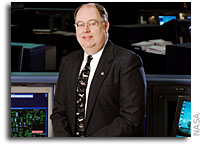Wayne Hale’s NASA Blog: Real Engineers

I earned an undergraduate degree in engineering from a prestigious and notoriously competitive university. After that I went on to do engineering research and complete a graduate degree in engineering from another major university with a reputation for excellence in engineering; along the way I wrote and defended a thesis and authored several papers which were published in professional engineering journals.
When I came to work for NASA, I was fortunate to get a job in the operations area: mission control. A thorough understanding of engineering principles and practices was mandatory for my job.
So I was floored just a few months later when I first heard it: “you are not a real engineer”. I was just “an ops guy”.
In the NASA pantheon of heros, the highest accolade any employee can be granted is that they are a “real engineer”. Not even astronauts rate higher. The heart of the organization worships at the altar of engineering: accomplishment, precision, efficiency. What does it take to be a “real engineer”?
In the ethos and mythology of NASA, a real engineer is one who has several characteristics.
First, they must have a superb grasp of the physics of their subject, a complete an total knowledge of the details of their specialty. This almost goes without saying. No nincompoops allowed; no fuzzy thinkers who are vague on the basic concepts. A “real engineer” knows his arcane stuff forwards and backwards and from the middle out towards both ends and can recite it in his sleep. “Let me tell you about the inviscid terms of the Navier-Stokes equation . . . ” a real engineer might say.
Second, a “real engineer” must create something, taking it from original concept to working, functioning reality. No view graph engineers ever get the title “real engineer”. If it doesn’t fly or move or compute or generate power, or do some concrete something, you haven’t built something real and without building something real, you are never going to be a “real engineer.” And the thing has to work; if it flops, then you are merely a tinkerer, not a “real engineer”.
Thirdly, “real engineers” are mild mannered; never needing to raise their voices, not loquacious, not given to long and convoluted discussions. No, real engineers are soft spoken and terse; they are recognized by their brevity and the ability to concisely summarize a technical point in a way that admits to no further discussion.
NASA is full of “real engineers”.
So us poor ops guys, who never had a drafting table, who never went into the machine shop to hand blueprints to a tech, who never got to blow up anything on the test stand; we failed miserably on the standard of being a “real engineer”. We merely operated the stuff that the real engineers built.
Along the same lines . . . .
I have been privileged to watch the advanced concept boys at work. They are marvelous. Through the study of all past and current rockets they have developed a number of “empirical models” — rules of thumb if you will — that can help in the initial ideas about building spacecraft. If you want to lift a certain number of metric tonnes to low earth orbit, given a particular rocket type (solid, liquid, hypergolic, cryogenic, hydrogen, kerosene, etc.) the advanced concept boys can give you a variety of options based on known ratios of structure weight to propellant weight, burn out mass, etc. And they can give you a rough guess at the cost. And they can evaluate multiple options and compare them one to another in very short order.
In the summer of 2002, I got to participate in an exercise for about two months of possible design options of manned missions to Mars. The advanced concept boys generated a new heavy lift launch vehicle about every other day and could compare all the designs against each other on a number of figures of merit. Its heady work to invent new Saturn V class rockets in the computer lab. Taller, shorter, with solid boosters or not, using kerosene or hydrogen or whatever. One engine, two engines, five engines, twenty engines; two stages, three stages, four. Whew. At the end of two months the team had a great list of options and the pros and cons for every launcher. And I found out that the advanced concept boys have been studying this problem for 40 years! They have evaluated hundreds, thousands of various options. Then they refined their studies, re-examined the basis for their methodologies and started in again.
But you know what? Advanced concept folks, even with all their knowledge of engineering principles, they are not “real engineers”.
Real engineering starts after the viewgraphs stop. Real engineers take the concept — boiled down as it may have been from hundreds of starting options — they take the concept and start making it real. When you have to really design and build the rocket in its detailed glory; when you have to take the subsystems out to the test stand and start them up and see if they hang together; when you go from weight estimates to actual plans and find out what the gizmo really does weigh — that is real engineering.
That is where you find out if the concept really will work or not; what the real problems are and how to solve them.
When the rocket really flies you have proof positive of the real stuff of engineering — and whether you have it or not.
That is what real engineering is all about.








